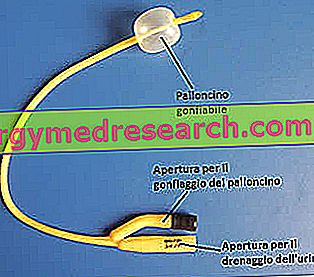Generality
Bladder catheterization is a medical procedure in which catheters are used to empty the bladder from urine. This intervention is necessary on several occasions: it can be used by those who cannot go to the bathroom because they are infirm, by those who are incontinent, by those who suffer from a temporary occlusion of the urethra, by whom must be operated on a pelvic organ and should get rid of urine etc.

The catheters used are called bladder catheters and, depending on the purpose, may have different characteristics. In fact, there are disposable catheters and long-use catheters.
The practice of bladder catheterization is not without risks and complications. For this reason, before using it, it is advisable to try to act with less dangerous alternative treatments.
Anatomical review: the urinary system
The urinary system consists of the kidneys and the urinary tract.
The kidneys are the main organs of the excretory apparatus . In number of two, they reside in the abdominal cavity, on the sides of the last thoracic vertebrae and of the first lumbar vertebrae, they are symmetrical and possess a shape that resembles that of a bean.
The urinary tract, on the other hand, form the urinary tract and consist of:
- Two ureters (one for each kidney). They are the ducts, which run from the kidneys to the bladder.
- The bladder . It is a small hollow muscular organ, which accumulates urine before urination.
- The urethra . Connected to the bladder, it is the duct that serves to lead the urine outside. In humans, it crosses the penis; in women, it is more and more short and flows into the vulva.
NB: under the bladder, only in men, there is another very important organ, the prostate, which produces and emits seminal fluid.
What is that?
Bladder catheterization is a medical procedure that serves to free the bladder from the urine contained in it. In other words, it is an artificial form of bladder emptying, when it is filled with urine.
HOW DOES Bladder CATHETERISM WORK?
Bladder catheterization involves the use of a thin and flexible tube, called a bladder catheter, which is passed through the urethra ( urethral bladder catheter ) or a hole made in the abdomen ( suprapubic bladder catheter ) and carried to the bladder.
The signal that the catheter has been correctly positioned is the immediate release of urine.
The bladder catheter is a latex, polyurethane or silicone catheter.
When practicing
Bladder catheterization is practiced in particular circumstances, which may be temporary (short-term bladder catheterization) or stable (long-term bladder catheterization).
The patients who need it are people with very different problems: among them, in fact, there are those who are struggling or unable to empty their bladder, who is incontinent, who needs to clean their bladder, who should prepare for surgery, etc.
SHORT-TERM VESICAL CATHETERISM
It is called bladder catheterization in the short term the artificial emptying of the bladder which serves to resolve temporary or temporary situations. This intervention is carried out on the following occasions:
- When an individual is waiting to be operated for urethral stricture, prostatic hypertrophy or kidney stones.
Urethral stricture is a partial or total occlusion of the urethra; prostatic hypertrophy is an enlarged prostate; kidney stones are small formations of mineral salts that restrict the urinary tract.
- Shortly before a long-term surgery or an operation on one of the following pelvic organs: large intestine, ovaries and uterus.
- When a woman is about to give birth.
- When the doctor suspects that there is a blood clot inside a patient's bladder.
LONG TERM CATHETERISM
Long-term bladder catheterization is defined as the emptying of the bladder performed to resolve stable circumstances and potentially able to last a lifetime.
It is generally practiced in the following cases:
- When an individual, due to severe debilitation, is permanently confined to a bed. This is the case, for example, of some very old people who are not even able to go to the bathroom.
- When an individual suffers from urinary incontinence . Urinary incontinence is the involuntary loss of urine, due to an overactivity of the detrusor muscle of the bladder or an incomplete closure of the latter.
- When the detrusor muscle is not very active ( hypocontrol of the detrusor or detrusor hypocontrol ).
- When there is a nervous damage, such that a subject is no longer able to govern urination.
Young and / or collaborative patients, who are forced to bladder catheterization in the long term, can resort to the so-called bladder autocateterismo, which consists in the autonomous insertion of the catheter every time they need it. This guarantees them a significant improvement in the quality of life, from the social sphere to the working sphere.
OTHER USES OF BAD CATHETERISM
So far we have talked about bladder catheterization as if it were just a procedure for emptying the bladder from urine. In reality, however, it can serve two other purposes, namely:
- When it is necessary to analyze a completely sterile urine sample. In fact, urine collected with normal urination is immediately contaminated as soon as it comes out of the urethra.
- When it is necessary to administer a drug (usually an anticancer chemotherapy) directly into a bladder with a tumor.
Types of bladder catheter
There are two types of bladder catheter: the urethral bladder catheter and the suprapubic bladder catheter .
Urethral bladder catheters are available in two versions: intermittent and on-site.
Suprapubic bladder catheters are only of the dwelling type.
Below, the properties of each of them will be described, with advantages and disadvantages.
BLADDER CATHETER WITH INTERMITTENCE
The so-called intermittent bladder catheter is a disposable urethral catheter that is inserted into the bladder and removed immediately after the latter is emptied.
Ideal for bladder catheterization, it is covered with a lubricating gel and at the same time anesthetic (it contains, in fact, lidocaine ) which facilitates entry into the urethra.
Those who use it, to eliminate urine, can go to a bathroom or, if there is no toilet available, can connect the catheter to a bag suitable for collecting liquids (which will then be emptied in the appropriate locations) . It is important to remember that, after positioning the catheter, the urine begins to leak immediately; therefore, if you are forced to use the bag, remember to connect it in advance to the catheter.
Before removal, to facilitate complete emptying of the bladder, it is advisable to lightly rotate the catheter or change posture.
Some frequently asked questions about the intermittent bladder catheter
- Is the insertion or removal of the catheter painful?
Both can be bothersome, especially in humans, where the urethra is longer.
- How can we learn bladder catheterization?
The patient is instructed by a professional nurse, who shows him how to insert it and how to remove it in the least annoying way possible.
- How many times a day do intermittent catheters be used?
It depends on the need; generally 4 to 6 times a day.

Figure: Foley type catheter or balloon catheter. The characteristic elements of the catheter are highlighted: the inflatable balloon and the two openings. In this case, the balloon was inflated to make it visible, but in reality, when the catheter is threaded, it must be deflated. From the site: chinamedevice.com

Figure: man's bladder catheter. The balloon is inflated only once the catheter has been introduced into the bladder, so as to prevent the catheter itself from slipping off. Inflation takes place by injecting a small amount of physiological solution through the appropriate opening. From the site: kidney.niddk.nih.gov
BUCKLE CATHETER
The so-called bladder catheter dwelling (or permanently ) is a urethral catheter of the Foley type which, once inserted into the bladder, can be kept in position even for two or three months.
Foley type catheters are completely characteristic: at one end, they have a balloon which, when inflated inside the bladder, prevents them from slipping off independently; at the opposite end, instead, they have two openings, one for eliminating urine, the other for inflating the balloon.
The urine outlet is connected to a collection bag; this bag is generally attached to a leg, so as to allow the patient to lead an almost normal life. Once filled with liquid, the bag must obviously be emptied.
There are bladder abutments fitted with a small regulating valve; this allows the bladder to be drained only in case of need, as people who do not use a bladder catheter normally do.
Since the insertion and extraction of a Foley urethral catheter requires certain skills, it is always necessary to consult a urologist and it is not possible to practice bladder catheterization.
With the help of the following figures, the reader can get a concrete idea of how a Foley-type bladder catheter, also known as a balloon catheter, functions .
The pros and cons of the standing catheter, compared to the intermittent catheter
Home bladder catheters guarantee the patient the chance to lead an almost normal life. In fact, they allow urination without having to go to a bathroom or another secluded place, as is required by intermittent catheters.
However, this enormous advantage is paid for with a greater frequency of complications and inconveniences, generally represented by urinary tract infections, bladder spasms, small leaks of urine etc. (see the chapter on risks).
OVERHEAD VESCAL CATHETER

Figure: Suprapubic bladder catheterization. The catheter used is a Foley type catheter, equipped with a balloon to prevent autonomous extraction. From the site: prontosoccorso.eumed.org
The suprapubic bladder catheter is a Foley-type catheter, which is inserted into the bladder through a hole in the abdomen. The perforation of the abdomen requires a small surgical operation, to be carried out under general anesthesia or under local anesthesia.
As with the urethral catheters in residence, the urine is collected in a special bag and its release can be regulated by means of a valve.
risks
The use of the bladder catheter can cause infections in the urinary tract, due to the entry of pathogenic bacteria into the body.
Moreover, it can give rise to spasms of the bladder, to small leaks of urine and to other disorders of different nature.
INFECTIONS OF THE URINARY SYSTEM
Urinary tract infections (urethra, bladder and ureters) or kidneys represent the most important and common danger of bladder catheterization. In fact, on average, they affect one person every 10 who use bladder catheters.
The greatest risk is run by those who resort to home catheters (urethral or suprapubic), since the latter, being kept in position for several weeks or months, are particularly exposed to bacterial contamination.
The most important symptoms of a urinary tract infection are the following:
- Bladder or urethral pain
- Bad and intense smell coming from the urethra
- Cloudy, foul-smelling urine
- High fever, above 38 ° C (sign not to be underestimated, as it generally indicates the extension of the infection to the kidneys)
- Feeling of general malaise
- Feeling tired and lethargic
At the slightest suspicion of an ongoing infection, it is advisable to contact the doctor immediately, as a delay in the start of antibiotic-based treatments could lead to unpleasant consequences.
Some patients may be prescribed preventive antibiotics to protect the body before it can be attacked by bacteria.
Attention : bladder catheterization, given the enormous incidence of infections at its expense, is a practice adopted only when alternative (and less dangerous) medical treatments have been ineffective.
OTHER RISKS AND COMPLICATIONS OF VESICAL CATHETERISM
In addition to bacterial infections, bladder catheterization may involve:
- Bladder spasms . They are abdominal cramps, sometimes very painful, due to the bladder that tries to expel the catheter in residence considered foreign. For those suffering from bladder bladder spasms, there are special medicines that can calm the frequency and intensity of cramps.
- Unexpected leaks of urine . A typical drawback of home catheters are real leaks of urine, which generally depend on a blockage of the catheter or its wrong positioning (following, for example, a spasm of the bladder).
- Accumulation of blood or debris inside the catheter . Blood and debris can block the leakage of urine, preventing emptying of the bladder. Like bladder spasms and urine leakage, these drawbacks are also typical of home catheters.
- Injury of the urethral canal . Inserting the urethral catheter can injure the urethra, causing a small trauma inside it.
- Narrowing of the urethra . Prolonged and repeated use of urethral catheters narrows the urethra because, by continuously stressing the walls of the urethral canal, it leads to the formation of abnormal scar tissue.
- Bladder stones (or bladder stones) . They are usually a consequence of years of bladder catheterization.
- Bladder or rectal bowel injury . They are due to incorrect insertion of the bladder catheter.



